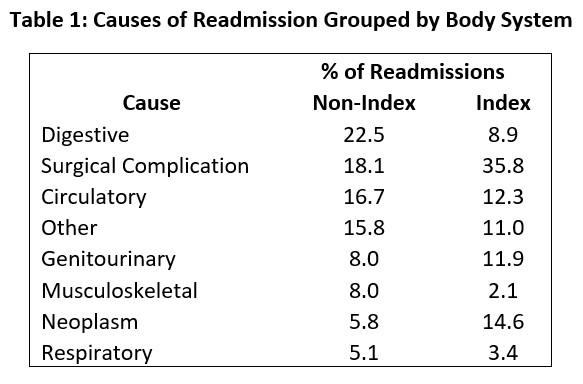Back
Quality of Care and Quality Improvement
19: Non-Index vs Index Readmissions Following Partial Nephrectomy: Causes, Costs, and Outcomes
Location: Poster Hall, Board B3
Width: 
Table 1: Causes of Readmission Grouped by Body System


Shiva Balasubramanian, B.A.
MS3
University of Missouri-Kansas City School of Medicine, United States
Poster Presenter(s)
Background: Partial nephrectomy is a standard treatment modality for localized renal malignancy, and post-operative readmission is an important care-quality metric. With regionalization of treatment to high-volume centers, care fragmentation in the form of non-index readmissions may occur. We sought to evaluate and compare 90-day non-index and index readmissions in terms of causes, costs, and outcomes as well as to identify risk factors for non-index readmission in the 2010-2014 Nationwide Readmissions Databases (NRD).
Methods: International Classification of Diseases-9 coding was used to extract patients with malignant renal neoplasms treated with partial nephrectomy from the NRD. Using χ2 and independent samples t-tests, variables were evaluated for association with non-index readmission; variables significantly associated with non-index readmission were included in our multivariable logistic regression analysis. The χ2 test was used to evaluate readmission visit outcomes. We defined statistical significance as p< 0.05.
Results: Out of 11,715 patients receiving a partial nephrectomy, 1,367 (11.7%) experienced 90-day readmission. Of these readmissions, 345/1,367 (25.2%) were to a non-index hospital and 1,022/1,367 (74.8%) were to an index hospital. Non-index readmissions had a significantly higher mean cost compared to index readmissions ($14,123±474 vs $13,863 ±371, p< 0.01). Readmission visit procedural utilization was significantly lower for non-index readmissions compared to index readmissions (23% vs 39%, p< 0.01). On multivariable analysis, longer index-visit length of stay was predictive for non-index readmission (OR 1.83, 95% CI 1.17–2.85). Congestive heart failure (OR 0.318, 95% CI 0.113–0.900) and electrolyte disorders (OR 0.41, 95% CI 0.219–0.768) were both protective against non-index readmission.
Conclusions: Non-index readmissions following partial nephrectomy, accounting for roughly 1 in 4 readmissions, are costlier than index readmissions. Increased index length of stay is a risk factor for non-index readmission. Elucidation of mechanisms driving non-index readmissions may guide preventative interventions.
Methods: International Classification of Diseases-9 coding was used to extract patients with malignant renal neoplasms treated with partial nephrectomy from the NRD. Using χ2 and independent samples t-tests, variables were evaluated for association with non-index readmission; variables significantly associated with non-index readmission were included in our multivariable logistic regression analysis. The χ2 test was used to evaluate readmission visit outcomes. We defined statistical significance as p< 0.05.
Results: Out of 11,715 patients receiving a partial nephrectomy, 1,367 (11.7%) experienced 90-day readmission. Of these readmissions, 345/1,367 (25.2%) were to a non-index hospital and 1,022/1,367 (74.8%) were to an index hospital. Non-index readmissions had a significantly higher mean cost compared to index readmissions ($14,123±474 vs $13,863 ±371, p< 0.01). Readmission visit procedural utilization was significantly lower for non-index readmissions compared to index readmissions (23% vs 39%, p< 0.01). On multivariable analysis, longer index-visit length of stay was predictive for non-index readmission (OR 1.83, 95% CI 1.17–2.85). Congestive heart failure (OR 0.318, 95% CI 0.113–0.900) and electrolyte disorders (OR 0.41, 95% CI 0.219–0.768) were both protective against non-index readmission.
Conclusions: Non-index readmissions following partial nephrectomy, accounting for roughly 1 in 4 readmissions, are costlier than index readmissions. Increased index length of stay is a risk factor for non-index readmission. Elucidation of mechanisms driving non-index readmissions may guide preventative interventions.
